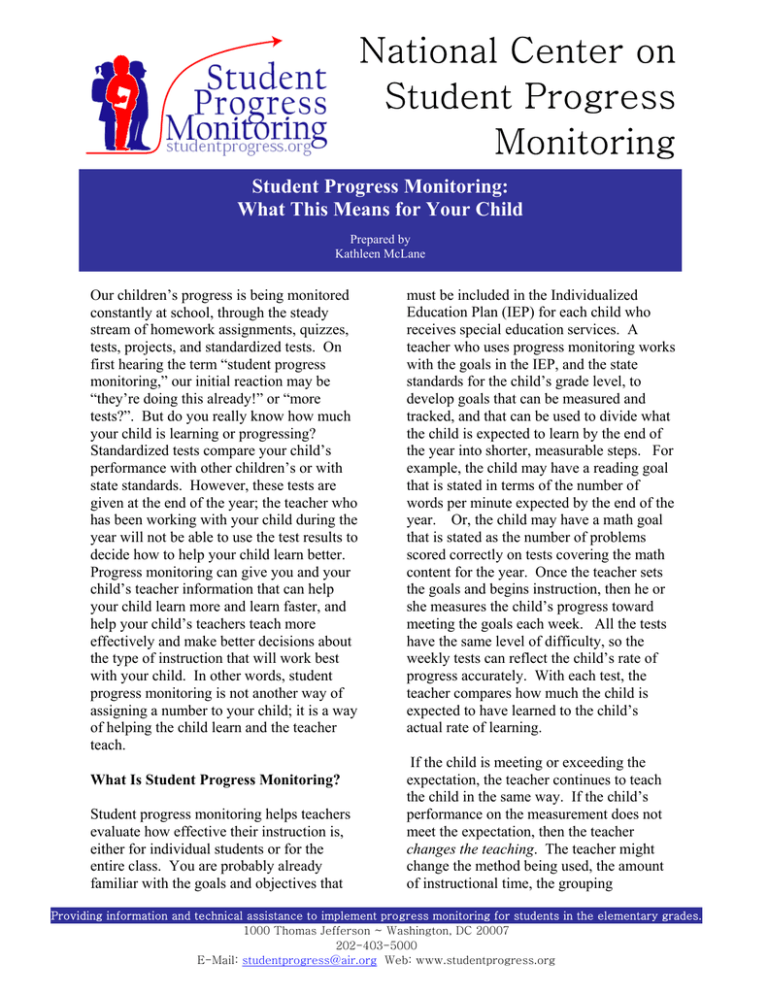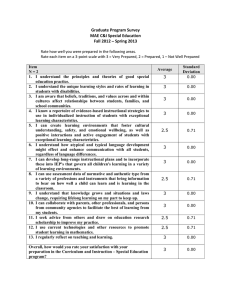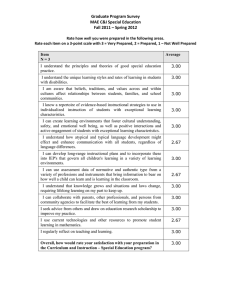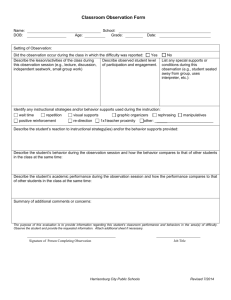National Center on Student Progress Monitoring
advertisement

National Center on Student Progress Monitoring Student Progress Monitoring: What This Means for Your Child Prepared by Kathleen McLane Our children’s progress is being monitored constantly at school, through the steady stream of homework assignments, quizzes, tests, projects, and standardized tests. On first hearing the term “student progress monitoring,” our initial reaction may be “they’re doing this already!” or “more tests?”. But do you really know how much your child is learning or progressing? Standardized tests compare your child’s performance with other children’s or with state standards. However, these tests are given at the end of the year; the teacher who has been working with your child during the year will not be able to use the test results to decide how to help your child learn better. Progress monitoring can give you and your child’s teacher information that can help your child learn more and learn faster, and help your child’s teachers teach more effectively and make better decisions about the type of instruction that will work best with your child. In other words, student progress monitoring is not another way of assigning a number to your child; it is a way of helping the child learn and the teacher teach. What Is Student Progress Monitoring? Student progress monitoring helps teachers evaluate how effective their instruction is, either for individual students or for the entire class. You are probably already familiar with the goals and objectives that must be included in the Individualized Education Plan (IEP) for each child who receives special education services. A teacher who uses progress monitoring works with the goals in the IEP, and the state standards for the child’s grade level, to develop goals that can be measured and tracked, and that can be used to divide what the child is expected to learn by the end of the year into shorter, measurable steps. For example, the child may have a reading goal that is stated in terms of the number of words per minute expected by the end of the year. Or, the child may have a math goal that is stated as the number of problems scored correctly on tests covering the math content for the year. Once the teacher sets the goals and begins instruction, then he or she measures the child’s progress toward meeting the goals each week. All the tests have the same level of difficulty, so the weekly tests can reflect the child’s rate of progress accurately. With each test, the teacher compares how much the child is expected to have learned to the child’s actual rate of learning. If the child is meeting or exceeding the expectation, the teacher continues to teach the child in the same way. If the child’s performance on the measurement does not meet the expectation, then the teacher changes the teaching. The teacher might change the method being used, the amount of instructional time, the grouping Providing information and technical assistance to implement progress monitoring for students in the elementary grades. 1000 Thomas Jefferson ~ Washington, DC 20007 202-403-5000 E-Mail: studentprogress@air.org Web: www.studentprogress.org arrangement (for example, individual instruction versus small-group instruction), or some other aspect of teaching. In this process, the teacher is looking for the type and amount of instruction that will enable the child to make enough progress toward meeting the goal. The measurements take from 1 to 5 minutes, so the child should not have the feeling of constantly being tested. In addition, since the teacher measures progress frequently – usually once a week – he or she can revise the instructional plan as soon as the child needs it, rather than waiting until a test or the state assessment shows that the child’s instructional needs are not being met. After each weekly measurement, the teacher notes your child’s performance level and compares it to previous measurements and to expected rates of learning. The teacher tracks the measurements on a graph as a way of showing the success of both the teacher and the student. What Information Should I Receive From the School? If a teacher, or a school, decides to implement student progress monitoring, you may receive a letter describing the program and how the teacher will be working with your child, or it may be discussed at your child’s IEP meeting. After that, you should receive regular feedback from the teacher on how well your child is doing, perhaps with a copy of the graph itself and information on instructional changes. If you do not receive the graph and instructional information, ask for it. For more information, visit www.studentprogress.org. This document was developed through Cooperative Agreement (#H326W0003) between the American Institutes for Research and the U.S. Department of Education, Office of Special Education Programs. The contents of this document do not necessarily reflect the views or policies of the Department of Education, nor does mention of trade names, commercial products, or organizations imply endorsement by the U.S. Government. This publication is copyright free. Readers are encouraged to copy and share it, but please credit the National Center on Student Progress Monitoring. Student Progress Monitoring: What This Means for Your Child 2



